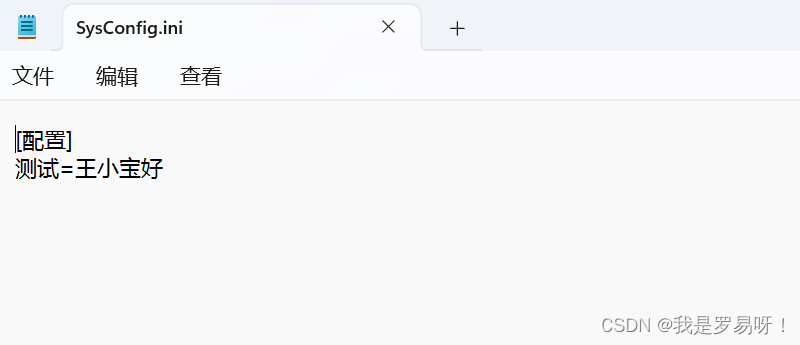热门标签
热门文章
- 1人工智能专业英语——术语与概念_人工智能专业英语anki
- 2【超全详解一文搞懂】Scala基础
- 3腾讯专家献上技术干货,带你一览腾讯广告召回系统的演进_腾讯召回算法冷冰
- 4注意力机制_location-based attention
- 5HarmonyOS Developer之开发准备--了解ArkTS_arkts可以开发网页吗
- 6ext-basex.js处理的同步请求在Firefox12、谷歌最新版本中不支持(在Firefox11中是支持的)怎么办?(已解答)_ext.js 3.0支持谷歌吗
- 7Transformer课程 业务对话机器人Rasa 3.x 持续集成 和持续部署_大模型 rasa
- 8Audified 假日捆绑销售和DW Enhancer 的价格变化_dw价格
- 9记java中用BigDecimal来解决数据类型不同及精确度高的相乘问题(多用于钱的计算...
- 10理解auth2.0授权码方式_&response_type=code&scope
当前位置: article > 正文
C#开发中一些常用的工具类分享
作者:Gausst松鼠会 | 2024-04-07 04:59:37
赞
踩
C#开发中一些常用的工具类分享
一、配置文件读写类
用于在开发时候C#操作配置文件读写信息
- 1、工具类 ReadIni 代码
using System; using System.Collections.Generic; using System.IO; using System.Linq; using System.Runtime.InteropServices; using System.Text; using System.Threading.Tasks; namespace TcpServer { public class ReadIni { [DllImport("kernel32")]// 读配置文件方法的6个参数:所在的分区(section)、 键值、 初始缺省值、 StringBuilder、 参数长度上限 、配置文件路径 public static extern long GetPrivateProfileString(string section, string key, string defaultValue, StringBuilder retVal, int size, string filePath); [DllImport("kernel32")]//写入配置文件方法的4个参数: 所在的分区(section)、 键值、 参数值、 配置文件路径 private static extern long WritePrivateProfileString(string section, string key, string value, string filePath); public static string FileNmae = "SysConfig.ini"; /*读配置文件*/ public static string GetValue(string section, string key) { string fileName = Directory.GetCurrentDirectory() + "/" + ReadIni.FileNmae; if (File.Exists(fileName)) //检查是否有配置文件,并且配置文件内是否有相关数据。 { StringBuilder sb = new StringBuilder(255); GetPrivateProfileString(section, key, "配置文件不存在,读取未成功!", sb, 255, fileName); return sb.ToString(); } else { return string.Empty; } } /*写配置文件*/ public static void SetValue(string section, string key, string value) { string fileName = Directory.GetCurrentDirectory() + "/" + ReadIni.FileNmae; WritePrivateProfileString(section, key, value, fileName); // 路径会自动创建 } } }
- 1
- 2
- 3
- 4
- 5
- 6
- 7
- 8
- 9
- 10
- 11
- 12
- 13
- 14
- 15
- 16
- 17
- 18
- 19
- 20
- 21
- 22
- 23
- 24
- 25
- 26
- 27
- 28
- 29
- 30
- 31
- 32
- 33
- 34
- 35
- 36
- 37
- 38
- 39
- 40
- 41
- 42
- 43
- 2、使用方法
// 自定义配置文件名称
ReadIni.FileNmae ="Config.ini"; // 默认SysConfig.ini
// 设置配置文件内容
ReadIni.SetValue("配置", "测试","王小宝好");
// 读取配置文件内容
string value = ReadIni.GetValue("配置","测试");
- 1
- 2
- 3
- 4
- 5
- 6
3、效果

二、日志记录类
在项目开发中我们经常要对业务进行日志记录,方便出现问题后对于故障的排查。这里我们使用C#实现了简单的日志记录功能。
- 1、日志记录类代码
using System; using System.Collections.Generic; using System.IO; using System.Linq; using System.Text; using System.Threading.Tasks; namespace TcpServer { public class Logger { private string logPath; private string DirPath; public Logger(string path) { DirPath = path; } public Logger() { DirPath = Directory.GetCurrentDirectory()+"/logs/"+DateTime.Now.ToString("yyyyMMdd"); } public void LogInfo(string message) { if (!Directory.Exists(DirPath)) { Directory.CreateDirectory(DirPath); } logPath = DirPath + "/log-info.log"; Log("INFO", message); } public void LogWarning(string message) { if (!Directory.Exists(DirPath)) { Directory.CreateDirectory(DirPath); } logPath = DirPath + "/log-warning.log"; Log("WARNING", message); } public void LogError(string message) { if (!Directory.Exists(DirPath)) { Directory.CreateDirectory(DirPath); } logPath =DirPath+ "/log-error.log"; Log("ERROR", message); } private void Log(string level, string message) { string logEntry = $"{DateTime.Now.ToString("yyyy-MM-dd HH:mm:ss")} - {level} - {message}{Environment.NewLine}"; File.AppendAllText(logPath, logEntry); } } }
- 1
- 2
- 3
- 4
- 5
- 6
- 7
- 8
- 9
- 10
- 11
- 12
- 13
- 14
- 15
- 16
- 17
- 18
- 19
- 20
- 21
- 22
- 23
- 24
- 25
- 26
- 27
- 28
- 29
- 30
- 31
- 32
- 33
- 34
- 35
- 36
- 37
- 38
- 39
- 40
- 41
- 42
- 43
- 44
- 45
- 46
- 47
- 48
- 49
- 50
- 51
- 52
- 2、使用方法
Logger Log = new Logger();
Log.LogInfo("记录一条日志信息");
Log.LogWarning("记录警告日志");
Log.LogError("记录错误日志");
- 1
- 2
- 3
- 4
- 3、记录效果

三、数据缓存类
数据缓存类是一个用C#实现的对数据进行缓存的简单功能
- 1、数据缓存类实现代码
using System; using System.Collections.Generic; namespace TcpServer { public class CacheHelper<TKey, TValue> { private readonly Dictionary<TKey, CachedItem> _cache = new Dictionary<TKey, CachedItem>(); public CacheHelper() { } public void Set(TKey key, TValue value,int tTime= 3600) { _cache[key] = new CachedItem { ExpTime= TimeSpan.FromSeconds(tTime), Created = DateTime.UtcNow, Value = value }; } public bool TryGet(TKey key, out TValue value) { CachedItem cachedItem; if (_cache.TryGetValue(key, out cachedItem) && cachedItem.IsValid) { value = (TValue)cachedItem.Value; return true; } value = default(TValue); return false; } public bool Remove(TKey key) { return _cache.Remove(key); } public void Clear() { _cache.Clear(); } // 辅助类,用于跟踪缓存项的创建时间和有效期 private class CachedItem { public TimeSpan ExpTime { get; set; } public DateTime Created { get; set; } public object Value { get; set; } public bool IsValid { get { return DateTime.UtcNow - Created < ExpTime; } } } } }
- 1
- 2
- 3
- 4
- 5
- 6
- 7
- 8
- 9
- 10
- 11
- 12
- 13
- 14
- 15
- 16
- 17
- 18
- 19
- 20
- 21
- 22
- 23
- 24
- 25
- 26
- 27
- 28
- 29
- 30
- 31
- 32
- 33
- 34
- 35
- 36
- 37
- 38
- 39
- 40
- 41
- 42
- 43
- 44
- 45
- 46
- 47
- 48
- 49
- 50
- 51
- 52
- 53
- 54
- 55
- 56
- 57
- 58
- 59
- 60
- 61
- 62
- 63
- 64
- 2、使用方法
CacheHelper<string, object> cache = new CacheHelper<string, object>();
// 设置缓存 缓存20秒
cache.Set("key1", "value1",20);
// 读取缓存
object value = string.Empty;
if (cache.TryGet("key1", out value))
{
return value;
}
- 1
- 2
- 3
- 4
- 5
- 6
- 7
- 8
- 9
- 10
- 3、使用效果需要用心体会

声明:本文内容由网友自发贡献,不代表【wpsshop博客】立场,版权归原作者所有,本站不承担相应法律责任。如您发现有侵权的内容,请联系我们。转载请注明出处:https://www.wpsshop.cn/w/Gausst松鼠会/article/detail/376521
推荐阅读
相关标签



